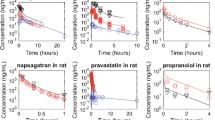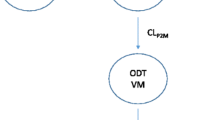ABSTRACT
Purpose
To predict the tramadol in vivo pharmacokinetics in adults by using in vitro metabolism data and an in vitro-in vivo extrapolation (IVIVE)-linked physiologically-based pharmacokinetic (PBPK) modeling and simulation approach (Simcyp®).
Methods
Tramadol metabolism data was gathered using metabolite formation in human liver microsomes (HLM) and recombinant enzyme systems (rCYP). Hepatic intrinsic clearance (CLintH) was (i) estimated from HLM corrected for specific CYP450 contributions from a chemical inhibition assay (model 1); (ii) obtained in rCYP and corrected for specific CYP450 contributions by study-specific intersystem extrapolation factor (ISEF) values (model 2); and (iii) scaled back from in vivo observed clearance values (model 3). The model-predicted clearances of these three models were evaluated against observed clearance values in terms of relative difference of their geometric means, the fold difference of their coefficients of variation, and relative CYP2D6 contribution.
Results
Model 1 underpredicted, while model 2 overpredicted the total tramadol clearance by −27 and +22%, respectively. The CYP2D6 contribution was underestimated in both models 1 and 2. Also, the variability on the clearance of those models was slightly underpredicted. Additionally, blood-to-plasma ratio and hepatic uptake factor were identified as most influential factors in the prediction of the hepatic clearance using a sensitivity analysis.
Conclusion
IVIVE-PBPK proved to be a useful tool in combining tramadol’s low turnover in vitro metabolism data with system-specific physiological information to come up with reliable PK predictions in adults.







Similar content being viewed by others
Abbreviations
- PBPK:
-
Physiologically-based pharmacokinetics
- IVIVE:
-
In vitro-in vivo extrapolation
- CLint:
-
Intrinsic clearance
- HLM:
-
Human liver microsomes
- rCYP:
-
Recombinant CYP450 enzyme systems
- ISEF:
-
Inter-system extrapolation factor
- ODT:
-
O-desmethyltramadol
- NDT:
-
N-desmethyltramadol
- NODT:
-
N,O-didesmethyltramadol
REFERENCES
Grond S. Clinical pharmacology of tramadol. Clin Pharmacokinet. 2004;43(13):879–923.
Subrahmanyam V, Renwick AB, Walters DG, Young PJ, Price RJ, Tonelli AP, et al. Identification of cytochrome P-450 isoforms responsible for cis-tramadol metabolism in human liver microsomes. Drug Metab Dispos. 2001;29(8):1146–55.
Whirl-Carrillo M, McDonagh EM, Hebert JM, Gong L, Sangkuhl K, Thorn CF, et al. Pharmacogenomics knowledge for personalized medicine. Clin Pharmacol Ther. 2012;92(4):414–7.
Gonzalez F, Tukey R. Drug metabolism. In: Goodman L, Gilman A, Brunton L, Lazo J, Parker K, editors. Goodman and Gilman’s the pharmacological basis of therapeutics. New York: McGraw Hill; 2006. p. 71–91.
Zhou SF. Polymorphism of human cytochrome P450 2D6 and its clinical significance: part I. Clin Pharmacokinet. 2009;48(11):689–723.
Tzvetkov MV, Saadatmand AR, Lotsch J, Tegeder I, Stingl JC, Brockmoller J. Genetically polymorphic OCT1: another piece in the puzzle of the variable pharmacokinetics and pharmacodynamics of the opioidergic drug tramadol. Clin Pharmacol Ther. 2011;90(1):143–50.
Stamer UM, Musshoff F, Kobilay M, Madea B, Hoeft A, Stuber F. Concentrations of tramadol and O-desmethyltramadol enantiomers in different CYP2D6 genotypes. Clin Pharmacol Ther. 2007;82(1):41–7.
Rowland M, Peck C, Tucker G. Physiologically-based pharmacokinetics in drug development and regulatory science. Annu Rev Pharmacol Toxicol. 2011;51(1):45–73.
Edginton AN, Theil FP, Schmitt W, Willmann S. Whole body physiologically-based pharmacokinetic models: their use in clinical drug development. Expert Opin Drug Metab Toxicol. 2008;4(9):1143–52.
Jamei M, Marciniak S, Feng K, Barnett A, Tucker G, Rostami-Hodjegan A. The Simcyp population-based ADME simulator. Expert Opin Drug Metab Toxicol. 2009;5(2):211–23.
De Bock L, Colin P, Boussery K, Van Bocxlaer J. Development and validation of an enzyme-linked immunosorbent assay for the quantification of cytochrome 3A4 in human liver microsomes. Talanta. 2012;99:357–62.
Bouzom F, Walther B. Pharmacokinetic predictions in children by using the physiologically based pharmacokinetic modelling. Fundam Clin Pharmacol. 2008;22(6):579–87.
Rostami-Hodjegan A. Physiologically based pharmacokinetics joined with in vitro-in vivo extrapolation of ADME: a marriage under the arch of systems pharmacology. Clin Pharmacol Ther. 2012;92(1):50–61.
Obach RS, Reed-Hagen AE. Measurement of Michaelis constants for cytochrome P450-mediated biotransformation reactions using a substrate depletion approach. Drug Metab Dispos. 2002;30(7):831–7.
Di L, Atkinson K, Orozco CC, Funk C, Zhang H, McDonald TS, et al. In vitro-in vivo correlation for low-clearance compounds using hepatocyte relay method. Drug Metab Dispos. 2013;41(12):2018–23.
Fagerholm U. Prediction of human pharmacokinetics-evaluation of methods for prediction of hepatic metabolic clearance. J Pharm Pharmacol. 2007;59(6):803–28.
R Core Team. R. A language and environment for statistical computing. Vienna: R Foundation for Statistical Computing; 2013.
Turner D, Rostami-Hodjegan A, Tucker G, Yeo K. Prediction of nonspecific hepatic microsomal binding from readily available physicochemical properties. Drug Metab Rev. 2007;38(S1):162.
Crewe HK. Are there differences in the catalytic activity per unit enzyme of recombinantly expressed and human liver microsomal cytochrome P450 2C9? A systematic investigation into inter-system extrapolation factors. Biopharm Drug Dispos. 2011;32(6):303–18.
Rostami-Hodjegan A, Tucker GT. Simulation and prediction of in vivo drug metabolism in human populations from in vitro data. Nat Rev Drug Discov. 2007;6(2):140–8.
Lintz W, Barth H, Osterloh G, Schmidt-Bothelt E. Bioavailability of enteral formulations 1st communication: capsules. Arzneimittelforschung. 1986;36–2(8):1278–83.
Lintz W, Barth H, Becker R, Frankus E, Schmidt-Bothelt E. Pharmacokinetics of tramadol and bioavailability of enteral tramadol formulations—2nd communication: drops with ethanol. Arzneimittelforschung. 1998;48(5):436–45.
Lintz W, Barth H, Osterloh G, Schmidt-Bothelt E. Pharmacokinetics of tramadol and bioavailability of enteral tramadol formulations—3rd communication: suppositories. Arzneimittelforschung. 1998;48(9):889–99.
Quetglas EG, Azanza JR, Cardenas E, Sadaba B, Campanero MA. Stereoselective pharmacokinetic analysis of tramadol and its main phase I metabolites in healthy subjects after intravenous and oral administration of racemic tramadol. Biopharm Drug Dispos. 2007;28(1):19–33.
Rodgers T, Leahy D, Rowland M. Physiologically based pharmacokinetic modeling 1: predicting the tissue distribution of moderate-to-strong bases. J Pharm Sci. 2005;94(6):1259–76.
Chen Y, Liu L, Nguyen K, Fretland AJ. Utility of intersystem extrapolation factors in early reaction phenotyping and the quantitative extrapolation of human liver microsomal intrinsic clearance using recombinant cytochromes P450. Drug Metab Dispos. 2011;39(3):373–82.
Yeo KR. Abundance of cytochromes P450 in human liver: a meta-analysis. Br J Clin Pharmacol. 2004;57(5):687–8.
Pedersen RS, Damkier P, Brosen K. Enantioselective pharmacokinetics of tramadol in CYP2D6 extensive and poor metabolizers. Eur J Clin Pharmacol. 2006;62(7):513–21.
Johnson TN, Rostami-Hodjegan A, Tucker GT. Prediction of the clearance of eleven drugs and associated variability in neonates, infants and children. Clin Pharmacokinet. 2006;45(9):931–56.
von Moltke LL, Greenblatt DJ, Duan SX, Daily JP, Harmatz JS, Shader RI. Inhibition of desipramine hydroxylation (cytochrome P450-2D6) in vitro by quinidine and by viral protease inhibitors: relation to drug interactions in vivo. J Pharm Sci. 1998;87(10):1184–9.
Li X, Song X, Kamenecka TM, Cameron MD. Discovery of a highly selective CYP3A4 inhibitor suitable for reaction phenotyping studies and differentiation of CYP3A4 and CYP3A5. Drug Metab Dispos. 2012;40(9):1803–9.
Poulin P, Theil FP. Prediction of pharmacokinetics prior to in vivo studies. 1. Mechanism-based prediction of volume of distribution. J Pharm Sci. 2002;91(1):129–56.
De Buck SS, Mackie CE. Physiologically based approaches towards the prediction of pharmacokinetics: in vitro-in vivo extrapolation. Expert Opin Drug Metab Toxicol. 2007;3(6):865–78.
Foti RS, Fisher MB. Impact of incubation conditions on bufuralol human clearance predictions: enzyme liability and nonspecific binding. Drug Metab Dispos. 2004;32(3):295–304.
Sjogren E, Nyberg J, Magnusson MO, Lennernas H, Hooker A, Bredberg U. Optimal experimental design for assessment of enzyme kinetics in a drug discovery screening environment. Drug Metab Dispos. 2011;39(5):858–63.
Shao L, Hewitt M, Jerussi TP, Wu F, Malcolm S, Grover P, et al. In vitro and in vivo evaluation of O-alkyl derivatives of tramadol. Bioorg Med Chem Lett. 2008;18(5):1674–80.
Zhang H, Sridar C, Kenaan C, Amunugama H, Ballou DP, Hollenberg PF. Polymorphic variants of cytochrome P450 2B6 (CYP2B6.4-CYP2B6.9) exhibit altered rates of metabolism for bupropion and efavirenz: a charge-reversal mutation in the K139E variant (CYP2B6.8) impairs formation of a functional cytochrome P450-reductase complex. J Pharmacol Exp Ther. 2011;338(3):803–9.
Zhao P, Zhang L, Grillo JA, Liu Q, Bullock JM, Moon YJ, et al. Applications of physiologically based pharmacokinetic (PBPK) modeling and simulation during regulatory review. Clin Pharmacol Ther. 2011;89(2):259–67.
Hallifax D, Houston JB. Saturable uptake of lipophilic amine drugs into isolated hepatocytes: mechanisms and consequences for quantitative clearance prediction. Drug Metab Dispos. 2007;35(8):1325–32.
Ito K, Houston JB. Comparison of the use of liver models for predicting drug clearance using in vitro kinetic data from hepatic microsomes and isolated hepatocytes. Pharm Res. 2004;21(5):785–92.
Foster JA, Houston JB, Hallifax D. Comparison of intrinsic clearances in human liver microsomes and suspended hepatocytes from the same donor livers: clearance-dependent relationship and implications for prediction of in vivo clearance. Xenobiotica. 2011;41(2):124–36.
Berezhkovskiy LM, Liu N, Halladay JS. Consistency of the novel equations for determination of hepatic clearance and drug time course in liver that account for the difference in drug ionization in extracellular and intracellular tissue water. J Pharm Sci. 2012;101(2):516–8.
Berezhkovskiy L, Wong S, Halladay J. On the maintenance of hepatocyte intracellular pH 7.0 in the in-vitro metabolic stability assay. J Pharmacokinet Pharmacodyn. 2013;40(6):683–9.
Poulin P, Hop CECA, Ho Q, Halladay JS, Haddad S, Kenny JR. Comparative assessment of in vitro-in vivo extrapolation methods used for predicting hepatic metabolic clearance of drugs. J Pharm Sci. 2012;101(11):4308–26.
ACKNOWLEDGMENTS AND DISCLOSURES
Karel Allegaert is supported by the Fund for Scientific Research, Flanders (Fundamental Clinical Investigatorship 1800214N).
Author information
Authors and Affiliations
Corresponding author
Rights and permissions
About this article
Cite this article
T’jollyn, H., Snoeys, J., Colin, P. et al. Physiology-Based IVIVE Predictions of Tramadol from in Vitro Metabolism Data. Pharm Res 32, 260–274 (2015). https://doi.org/10.1007/s11095-014-1460-x
Received:
Accepted:
Published:
Issue Date:
DOI: https://doi.org/10.1007/s11095-014-1460-x




